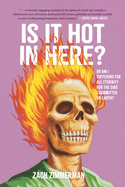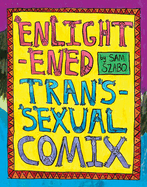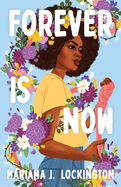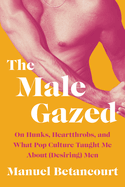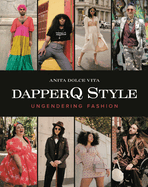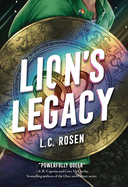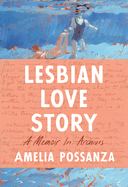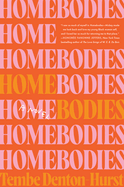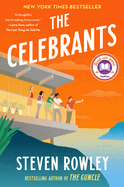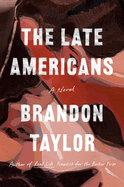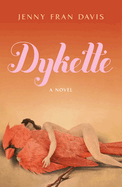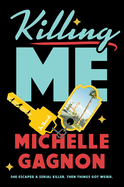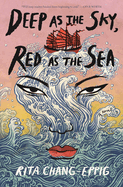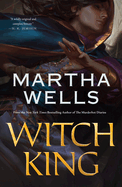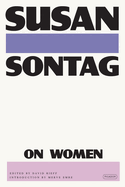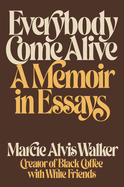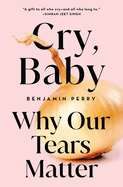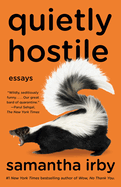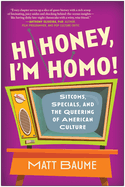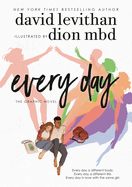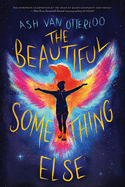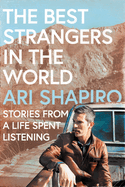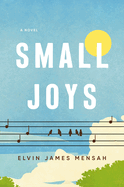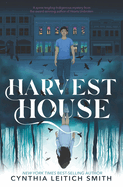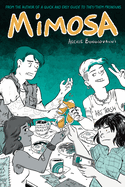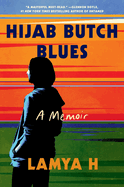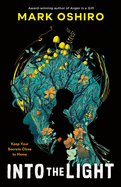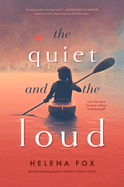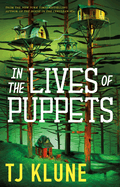Friday, June 2, 2023
Welcome to Shelf's LGBTQ+ issue! Stand-up comedian Zach Zimmerman serves up "a smorgasbord of hilarious anecdotes" in Is It Hot in Here; Anita Dolce Vita's DapperQ Style: Ungendering Fashion is "a gorgeously designed feast for the eyes," with photos and interviews with more than three dozen contributors; Forever Is Now, the debut YA "emotional verse novel" from Mariama J. Lockington, features a 16-year-old queer Black teen trying to find her voice; and Indonesian illustrator/designer Dion MBD transforms author David Levithan's Every Day into "a compelling graphic edition." Plus so many more!
Amelia Possanza in The Writer's Life discusses the historical and personal elements of Lesbian Love Story: A Memoir in Archives; and Sacha Lamb talks about her 2023 Stonewall Award winner, When the Angels Left the Old Country.
Homebodies
by Tembe Denton-Hurst
Tembe Denton-Hurst debuts with a novel filled with strength, emotion, and wit. Homebodies follows a Black, queer woman fighting injustice in the workplace, with a plot that compels readers to root for her to find her way. Mickey Hayward's impressive-sounding New York City writing job is all she ever wanted (on paper). But all the topics she wants to write about--her identities and culture--get shut down by her anxiety-inducing boss, Nina. Mickey muses on her beginnings at Wave magazine: "Everything was a story that would change the conversation as they now knew it. Everyone was grateful for her perspective." Now, Wave didn't want her perspective at all; even though she dreamed of someday doing more, she didn't expect to get fired.
Her new unemployment status sparks weeks on the couch, losing herself to uncertainty and doubt. Her feelings develop into rage toward the industry she continuously saw pushing Black women out, leading her to write a manifesto about the racism and sexism she faced at Wave. Mickey decides to find solace with her family at home after receiving little support from her industry friends and feeling strain in her relationship with her girlfriend, Lex. With additional identity-questioning challenges in Maryland, Mickey is even more lost.
Denton-Hurst's prose doesn't miss a beat, following Mickey's struggle to rediscover herself and what she truly wants from life and love. Her bravery and strength make her a beacon of hope for equity and inclusion in the workplace. --Clara Newton, freelance reviewer
Discover: Homebodies, a vibrant display of bravery in the face of adversity, features witty and intimate prose and illuminates the injustices Black and queer women face in the workplace.
The Celebrants
by Steven Rowley
Five friends who met as classmates at Berkeley in the mid-1990s invent an unusual pact to cement their bond in The Celebrants, a witty novel by Steven Rowley (The Editor; Lily and the Octopus). The pact was born of tragedy: shortly before Naomi, Marielle, Craig, Jordan, and Jordy were about to graduate, their friend Alec died of an apparent overdose. This tragedy taught them that time and friendships are precious, so they agree "to throw their funerals while they were still living so that none of them could ever question exactly what they meant to the others." Anyone could trigger the pact at any time. The one requirement of the other attendees: "Leave nothing left unsaid." In 2023, Jordan, now married to Jordy, calls in his request but for a painful reason: he's dying of cancer.
The novel highlights each character's story: Marielle's need for "celebration, community, [and] love" after a painful divorce; music executive Naomi summoning everyone for her funeral after her parents die in a plane crash; art dealer Craig facing jail time for his involvement in a fraud. These characters resort too often to glibness, but in Rowley's capable hands--among the nice touches are chapter titles that cleverly reference songs from the Carpenters, which the friends like to sing--genuine feelings slowly emerge. The result is a tender reminder of the exigencies of life and the remarkable ability of happy memories to melt the years away. --Michael Magras, freelance book reviewer
Discover: In The Celebrants, five college friends make a pact: at any time in their lives, one of them can ask for a "funeral" to be reminded of how much they've meant to the others.
The Wishing Game
by Meg Shaffer
Charlie and the Chocolate Factory meets Mr. Lemoncello's Library with a grownup twist in Meg Shaffer's whimsical, wistful first novel, The Wishing Game.
Lucy's only wish in life is to adopt Christopher, an orphaned seven-year-old stuck in the foster system. Her meager teacher's-aide pay and multiple-roommate living situation disqualify her as a potential mom. Her dream gets a surprise second chance when she receives an invitation to the remote island home of reclusive mega-bestselling children's author Jack Masterson, who hasn't released a new book in years. Masterson has at last written a new book in his wildly popular, long-running children's series Clock Island, and he's holding a competition for ownership of the single existing copy. If Lucy wins, she can sell the book for enough money to start a new life with Christopher.
In Masterson's quirky Victorian mansion on the real Clock Island, off the coast of Maine, Lucy will pit her riddle-solving skills and lifelong fan's knowledge of Clock Island against competitors who share a special commonality with her: each of them ran away to Clock Island as children. Shaffer tenderly portrays lost souls finding each other in this feel-good story that will ignite nostalgia for those most-loved reads from childhood. Lucy's steadfast yearning to give a bereft boy the love and attention her parents never gave her is a solid, complex emotional anchor for the fairy-tale concept. Anyone who has ever dreamed of escaping into the world of a book should find resonance here, not to mention an affirmation of their inner child. --Jaclyn Fulwood, blogger at Infinite Reads
Discover: A young woman accepts an invitation to a Wonka-esque competition in this whimsical, emotionally deep novel of second chances.
The Late Americans
by Brandon Taylor
Brandon Taylor's The Late Americans offers an insightful and razor-sharp portrait of the interconnected lives of a cohort of writers, dancers, and thinkers living in the contemporary American Midwest. Seamus is a white, aspiring poet but his holier-than-thou writer's MFA workshop makes him viscerally sick. Ivan is an ex-dancer building a career in finance on the back of money raised by his pornography. And Fyodor is a mixed-race worker in a beef processing plant who can't stop pushing away his partner. Together with a whirlwind of other figures who swirl in and out of each other's lives in Iowa City, these characters share friendships and emotional fallouts, triumphs, and betrayals, forever grappling across the fault lines of race, sexuality, and class.
Like other works by Taylor (Real Life; Filthy Animals), The Late Americans demonstrates a nuanced understanding of not only individual characters but the social worlds that tie them inextricably together. Taylor's characters unfold through specific, recognizable details, like Fyodor's tenderness toward the meat he cuts, "which was rather soft and delicate, like cloth or dough. You had to respect its natural geometry"; or Seamus's particularly acute yet distant experiences of pain: "There was a faint rattle in his chest when he breathed.... His shoulder ached. He put his thumb into his mouth and bit hard on the gristle at its edge. There was a sharp prick of pain, and then only dull heat." But it's the way these people interact with each other, from new perspectives and in new contexts, like chemicals transforming in solutions, that results in a deeply evocative portrait of anxiety and vulnerability, ambition, and intimacy. --Alice Martin, freelance writer and editor
Discover: A splendidly wrought and emotionally engrossing novel consisting of linked character portraits, The Late Americans continues to cement Brandon Taylor as a standout literary voice.
Dykette
by Jenny Fran Davis
In Dykette, the scintillating first novel by Jenny Fran Davis, Sasha and her butch lover, Jesse, are on a holiday getaway with two other lesbian couples. Through casual mealtime conversation and sultry sauna sessions, this cozy retreat becomes a turning point in Sasha's relationships, with the others as well as herself, as she turns a critical gaze upon what is said and what is left unsaid in the icy woods of upstate New York.
While the others seem to relax easily into the rustic accommodations, Sasha is anything but calm. For her, every object carries significance, every desire is a performance, status is crucial, and drama simmers below every surface. In Sasha's thinking, these power lines hold the potential to jolt a fully fledged identity into existence, one that inspires the adoration she so desperately seeks. But instead of acting as conduits to a fulfilling relationship, dynamite sex life, and profound self-actualization, her talismans tangle her in a web of her own making.
Although Sasha is savvy and analytical, everything that can truly satisfy her appetites seems to hover just out of reach. Jesse reserves the pearl dildo for Sasha alone, but can be evasive about long-term commitments. Her crush on Jules Todd ushers her into the professional newscaster's elite orbit, but is their flirty sexual tension all in Sasha's head?
Davis carves a finely sculpted pantheon of lesbian archetypes to consider, all in orbit around Sasha's esteem for the bimbo, the minx, the dykette. Gossipy and uninhibited, Dykette burnishes the intrinsically queer question of how to cultivate a reliable sense of belonging. --Dave Wheeler, associate editor, Shelf Awareness
Discover: At the center of this dishy, uninhibited novel about three lesbian couples on a rustic holiday getaway lies the beating heart of an irresistible desire to be irresistibly desired.
Mystery & Thriller
Killing Me
by Michelle Gagnon
Michelle Gagnon's Killing Me tells the story of a relentless serial killer hunting a con woman across the country. Gagnon's fifth adult mystery is terrifically off-kilter, veering as it does from laugh-out-loud humor to its hard-edged plot points. A funny serial-killer novel has inherent problems, but Gagnon (Unearthly Things; Strangelets) handles the comic moments with aplomb.
The first chapter of Killing Me embodies both humor and terror, as frightened college student Amber Jamison finds irony in the fact that's she's about to be the Pikachu Killer's latest victim. Torture seems imminent, but Amber just can't take seriously a killer who paints his victims to resemble a Pokémon character. Moments before she's strangled, Amber is saved by a masked woman who kills Amber's captor with a cattle prod. Amber fears she can't report this to the police, given that she has been a grifter bilking people since she was a teenager, so the 24-year-old flees Johnson City, Tenn., just two months shy of getting her degree in psychology. She arrives in Las Vegas--and has been followed by another serial killer and her rescuer.
The thread of betrayal runs through Killing Me: each character may be conning the other. Amber lands at a sleazy motel where she becomes friends with the owner, who's involved with an amateur sleuth group; a sex worker to whom Amber is attracted; and the masked woman, who calls herself Grace. None can be trusted, including the killer who ramps up the body count. Killing Me's brisk action keeps the believable surprises coming. --Oline H. Cogdill, freelance reviewer
Discover: A young grifter is targeted by a serial killer in this tense thriller that offers plenty of surprises and a bit of humor.
Death Comes to Marlow
by Robert Thorogood
Fiction has its share of elderly female amateur sleuths, but most of them aren't known to skinny-dip in the river Thames. Judith Potts--widow and professional crossword setter--is a category-all-her-own creation of Robert Thorogood, who follows the Edgar Award-nominated The Marlow Murder Club with Death Comes to Marlow, a singularly clever locked-room mystery.
Judith is outside at a party hosted by Sir Peter Bailey on the eve of his second marriage when everyone hears a terrific crash from within the house. They scurry inside, and Tristram, Sir Peter's son from his first marriage, breaks down the locked door to his father's study. They find Sir Peter alone and dead, crushed by a mahogany cabinet. Tristram would seem to be the prime suspect--he'd lose his path to inheritance upon his father's remarriage--but Judith wonders: "How did he manage to kill his father considering he was outside talking to us when he died?" Furthermore, how was Sir Peter murdered when his study door was locked from the inside?
An elder sleuth in a pastoral setting is a hallmark of the cozy mystery, and Thorogood writes with coy awareness of the subgenre, as when Judith sheepishly admits that she got some of her detective smarts from Murder, She Wrote. As for the plot, Thorogood leaves hints throughout Death Comes to Marlow that only Judith manages to piece together by novel's end. At one point someone says to Judith of her cryptic crosswords, "Your clueing is wonderful." So is Thorogood's. --Nell Beram, author and freelance writer
Discover: This follow-up to The Marlow Murder Club is a singularly clever locked-room mystery solved by a category-all-her-own elder sleuth.
Science Fiction & Fantasy
Deep as the Sky, Red as the Sea
by Rita Chang-Eppig
Rita Chang-Eppig's sharp, gritty first novel, Deep as the Sky, Red as the Sea, takes readers on a high-seas adventure alongside a legendary Chinese pirate queen who must reckon with government crackdowns on piracy and encroaching Europeans in the early 1800s.
Shek Yeung is co-commander of the Red Banner Fleet and Scourge of the South China Sea when her husband, fleet commander Cheng Yat, dies in battle against Portuguese sailors. Now that her greatest supporter is dead, she must secure her position as leader and keep her boats and crew safe in the face of the emperor's violent crusade against piracy. Shek Yeung is no stranger to survival situations, though. A youth spent in forced prostitution on the flower boats after pirates murdered her family honed her skill at strategy, the quality that motivated her husband to abduct and marry her in the first place. She swiftly seeks a consolidation of power by marrying her husband's second-in-command, Cheung Po, who shares with her the distinction of having been both Cheng Yat's protege and captive. She fears her new husband may assassinate her and take full command of the fleet, but instead he seems bent on impressing her. Soon Shek Yeung must outwit a ruthless nobleman and uncover a plot by aggressive European powers, while struggling through a complicated pregnancy.
This fascinating portrait of a woman determined to survive no matter the challenge will captivate readers' imaginations. Book clubs and solo readers alike should find much food for thought in this blend of high-stakes action and a complex character sketch of a fierce and wily leader. --Jaclyn Fulwood, blogger at Infinite Reads
Discover: This gritty historical adventure on the high seas is based on the life of a legendary Chinese pirate queen.
Witch King
by Martha Wells
Martha Wells (the Murderbot Diaries, the Books of the Raksura), winner of Hugo, Nebula, and Locus Awards, is at her best in Witch King, a captivating, original fantasy that expertly balances character and world-building. Wells knows how to immediately hook readers: Kai, a demon known as the Witch King, wakes up in a submerged glass coffin with no memory of how he got there or how long he's been trapped. In this action-packed opening scene, Kai fuels his magic by extracting pain from a dead body dragged in by a magic-wielder who seeks to enslave him. Kai uses that pain magic to take over and heal that soulless body, dispatch the bad guys, and rescue his Witch friend Ziede and a young mortal girl, Sanja. Soon the three set out to save Ziede's wife, Tahren, and sort through a mess of epic proportions.
Alternating chapters set in the past allow Wells to develop political and personal relationships amidst the war to defeat the Hierarchs. This context sets up Kai and Ziede's new quest several decades later as they discover Tehran's disappearance is connected to a multifaceted conspiracy and ongoing threats from those who allied with the Hierarchs. With high stakes, dark magic, and layered conflicts, this could be a brutal novel. It isn't. Even though he's a demon who derives his magic from pain, Kai's wry humor and innate goodness anchors Witch King. Wells's queer-normative world-building and masterful character development are sure to please new and established fans alike. --Suzanne Krohn, librarian and freelance reviewer
Discover: Fantasy readers and Murderbot fans will want to pick up this epic fantasy for its distinctive world-building, complicated and endearing characters, and riveting plot.
Graphic Books
Enlightened Transsexual Comix
by Sam Szabo
Cartoonist Sam Szabo opens her sidesplitting collection of comic strips with a disarming introduction to the Enlightened Transsexual, a cosmic entity so advanced as to have "experienced life as at least three genders... tantamount to omnipotence." She is brimming with wisdom and willing to entertain the burning questions of mere mortals: "What an opportunity this is for you." It's this mixture of earnestness and egotism that provides the backbone for what is a truly hilarious body of work.
Each vignette, such as "The Enlightened Transsexual in 'Transcendental Medication'" and "...Census and Sensibility," is a veritable buffeting of punch lines. A census worker at the door learns that the ET's birthplace was primordial ooze, her orientation is chaotic neutral, and her preference for Mac or PC is a much too personal question to answer. These gags are assembled in vibrant and psychedelic drawings that have just the right amount of frenzied verve to nail the irreverent, and sometimes unhinged, sense of humor behind them.
What grounds these comics, though, is a poignant attention to the indignities that trans people face in a world filled with absurdities. In the increasingly meta latter half, the ET descends on a younger version of herself with some tough love about how camp and silliness is one way of refusing to let her hecklers win. "Is a little panache too much to ask for?" she says, more than a little annoyed with her own timidity. Perfectly balanced and ridiculously funny, Enlightened Transsexual Comix is an out-of-this-world parade of earthly delights, for fans of Lynda Barry and Adult Swim. --Dave Wheeler, associate editor, Shelf Awareness
Discover: This sidesplitting collection of queer comics wrangles the wildly funny and wonderfully postmodern daily dilemmas of a cosmic being who is "sexier than God."
Biography & Memoir
Lesbian Love Story: A Memoir in Archives
by Amelia Possanza
In her audacious heartthrob of a memoir, Amelia Possanza revives seven queer romances from the past, hoping to better understand her own lesbian identity. "I was certain that if I uncovered enough lesbians in history, they would reveal... a blueprint of how I might build my own life," she writes in the introduction to Lesbian Love Story. What she discovers, however, by scouring libraries for figures obscured by historical bias, is nothing so prescriptive. She finds an expansive and adaptable collective that spans centuries and includes female husbands, drag kings, Olympic athletes, political activists, caregivers, and more.
Possanza converses with these historical lesbians through a dazzling approach to shared text, injecting her prose with their preserved words, transferred from diaries and interviews. She lays bare her own yearnings and insecurities alongside those of her forebears in a moving assertion of belonging. One subject, Rusty, was institutionalized for her gender deviance and threatened with shock treatment. Possanza relays Rusty's testimony in italics: "I found a nurse's uniform in the closet, I put it on and I just walked out of the hospital." Possanza then observes, "Rusty always did seem to understand the power of a uniform"--to grant a person access to bathrooms and employment, as well as a kind of authenticity that Possanza still grapples with herself.
Her vulnerability is matched only by her sense of joy in discovering an ongoing and shifting discussion about "women who love women" and others who exist outside of such easy definitions, while persevering with a distinctly lesbian worldview. Lesbian Love Story is a triumph, as romantic as it is perceptive. --Dave Wheeler, associate editor, Shelf Awareness
Discover: A curious and vulnerable trip through the archives gives one modern-day lesbian clues to what that word has meant to the generations who came before her.
Social Science
The Male Gazed: On Hunks, Heartthrobs, and What Pop Culture Taught Me About (Desiring) Men
by Manuel Betancourt
Culture writer and film critic Manuel Betancourt (Judy Garland's Judy at Carnegie Hall) makes gender theory both accessible and fun as he unpacks something like the male equivalent of a hope chest, brimming with all the idealized forms of masculinity thrust upon him and practically everyone else assigned male at birth. That he turned out gay only added to his complex feelings about what it means to be a man. In The Male Gazed, he turns his keen eye on masculine signifiers, like bulging muscles, an ineffable swagger, and a simple pair of classic white briefs.
The male object presents a distinct challenge for study, however, and Betancourt calls this out: "Granting itself claims to authority as well as universality, masculinity has rarely offered itself up for examination; it has always been subject, never object." But anyone familiar with masculinity's fragility is likely to wonder why it always seems to be in crisis.
Showcasing versatile insightfulness, Betancourt draws on distinctly Latin frames of reference from his Colombian roots (the "berraco" gender theory of Javier Omar Ruíz Arroyave, the Spanish-language films of Pedro Almodóvar, and the opulent legacy of astrologer Walter Mercado) just as handily as he considers a scatterplot of international guideposts (muscle-bound characters in Japanese anime and the queer underpinnings of villainous Disney daddies like Gaston and Jafar). This breadth of inquiry makes The Male Gazed feel well considered and charmingly personal as Betancourt denudes manhood of its preciousness. What he uncovers may be just enough to begin salvaging a robust and dynamic sense of masculinity from the toxic strains that have become so prevalent in social discourse. --Dave Wheeler, associate editor, Shelf Awareness
Discover: Drawing on a broad range of references, Manuel Betancourt parses masculinity's rigorous expectations in search of an antidote to its most toxic strains.
DapperQ Style: Ungendering Fashion
by Anita Dolce Vita
DapperQ Style: Ungendering Fashion is a gorgeously designed feast for the eyes. Building on her experience with the queer fashion magazine DapperQ, Anita Dolce Vita gathers and amplifies a multitude of queer voices talking about fashion, visibility, identity, belonging, self-image, liberation, and more. Dolce Vita interviews more than three dozen people of a variety of genders, sexual orientations, ages, sizes, races, and ethnicities--all accompanied by vibrant photographs showcasing each contributor's personal style.
The first of three sections in the book, "Visibility," considers the ways that queer people use fashion to make themselves visible, with nods to hanky codes and carabiner signals. The second section, titled "Belonging," explores the joy of using fashion to feel like part of a group, and the third section, "Liberation," focuses on queer fashion as freedom from restrictive societal norms, freedom to find and fully express oneself. Individual accounts chronicle the formative experiences of queer people interested in fashion, from childhood to adolescence and adulthood. Some stories are about the struggle of coming out or fitting in; some, about support from family or friends; and others, especially from younger contributors, about the joy of being able to explore identity through fashion. Vectors of identity are mentioned as key components of the queer experience in fashion, with particular attention to Black queer experiences. Thoughts about the effects of the Covid quarantine on personal style, the fashion world, and mental health appear throughout this collection, deepening an already thought-provoking treatment of queer style and fashion. --Dainy Bernstein, literature professor, University of Pittsburgh
Discover: A celebratory explosion of queerness and fashion, DapperQ Style: Ungendering Fashion will pull readers back again and again to savor the freedom and joy in its pages.
Essays & Criticism
On Women
by Susan Sontag
During her lifetime, Susan Sontag (1933-2004), the great public intellectual and author (Debriefing), had a nuanced relationship with feminism. She championed women's complete equality, but she didn't fully align herself with the women's movement of her time. On Women--which gathers characteristically gimlet-eyed essays and other examples of Sontag's writing, plus one interview, all from 1972 through 1975--leaves no doubt about her feminist bona fides.
"I have always been a feminist," Sontag writes in "The Third World of Women," in which she admonishes, "As often as not women should light men's cigarettes for them, carry their suitcases, and fix their flat tires" in the interest of demonstrating women's equality with men. But Sontag didn't look at feminism--or anything, for that matter--uncritically, and several pieces make clear that she found it hard to square herself with what she perceived as the movement's anti-intellectualism. "Like all capital moral truths, feminism is a bit simple-minded," she writes in "Feminism and Fascism," a cordially rancorous exchange of letters between Sontag and the poet and unapologetic feminist Adrienne Rich that appeared in the New York Review of Books in 1975.
A half century on, the pieces in On Women have aged remarkably well, and anything somewhat dated (from "The Double Standard of Aging": "Women do not develop their bodies, as men do") has aged in an encouraging direction. This slim and (largely) accessible book serves as both a primer on the women's movement's second wave and an excellent Susan Sontag starter kit. --Nell Beram, author and freelance writer
Discover: This slim and (largely) accessible collection of Susan Sontag's writings from the 1970s serves as both a primer on the women's movement's second wave and an excellent Susan Sontag starter kit.
Religion
Everybody Come Alive: A Memoir in Essays
by Marcie Alvis Walker
Marcie Alvis Walker's powerful debut memoir, Everybody Come Alive, plumbs the depths of her experience as a Black woman in America. The "youngest and darkest" of five children born to a single mother who wrestled with mental illness, Walker spent her childhood shuttling between her mother's house and her grandparents' home in a predominantly white neighborhood (where she attended school). The early contradictions Walker absorbed about race, especially as a woman, have informed her experience into adulthood and the work she does online through her website, Black Coffee with White Friends.
In conversational, truth-telling prose, Walker shares her experiences of the mingled love and racism she experienced as a child; the contrast between her beliefs in a loving, inclusive God and her experiences of church and other communities; and the process of advocating for her transgender child, especially in primarily white spaces. She's honest about having to unlearn her own prejudices, and she calls on her white readers to seek out diverse stories. Brief essays between the longer chapters pull in other voices from Black music and film and from the headlines: Sandra Bland, Tamir Rice's mother, other Black Americans who struggle under the weight of systemic racism. Walker doesn't shy away from her family's messy story, including her mother's struggles and their complicated relationship. Regardless of mess, though, Walker is insistent that everyone, no matter their skin color, deserves a life where they feel beloved and truly alive. --Katie Noah Gibson, blogger at Cakes, Tea and Dreams
Discover: Marcie Alvis Walker's powerful memoir explores her experiences as a Black woman in America and the mother of a transgender child.
Psychology & Self-Help
Cry, Baby: Why Our Tears Matter
by Benjamin Perry
Prepare for some excellent crying sessions with Benjamin Perry's debut book, Cry, Baby: Why Our Tears Matter. Perry draws on his background in psychology and queer progressive Christian ministry--supplemented with conversations with leaders from multiple faiths and activist groups--to explore and invite readers to join him in the act of crying.
Perry opens with the story of his realization that he hadn't cried for 12 years and his quest to reconnect with everything that weeping offers. The next chapters widen the narrative with other people's stories to illustrate scientific and literary ideas about the power of emotional tears. The middle chapters address how crying is mapped onto bodies of various identities in the United States, accompanied by gendered and racialized expectations, and the last chapters examine the paradigm-shifting potential of tears on national and global levels.
Cry, Baby holds space for those marginalized by a culture whose relationship with tears and vulnerability is marked by the worst parts of white American capitalistic history. Perry points to social media trends, and Gen Z's consciously radical tears as disruptive of white American capitalism and, therefore, revolutionary. The book's tone is uplifting even when focused on outrage about harmful mockery of genuine tears and weaponization of crocodile tears, with vividly poetic lines like "our lacrimation doesn't just help us communicate; it whispers secrets about ourselves--our fervent hopes and aching longing." Turning to his ministry experience, Perry ends with "A Blessing for Crying," the perfect summation of this excellent book. --Dainy Bernstein, literature professor, University of Pittsburgh
Discover: In Cry, Baby: Why Our Tears Matter, Benjamin Perry explores the revolutionary power of tears with wit, humor, empathy, and hope.
Humor
Is It Hot in Here (Or Am I Suffering for All Eternity for the Sins I Committed on Earth)?
by Zach Zimmerman
If comedy equals tragedy plus time, then Zach Zimmerman must be a math wiz! Is It Hot in Here (Or Am I Suffering for All Eternity for the Sins I Committed on Earth)? collects 30 essays, listicles, object lessons, and meditations, each a punchy, soulful response to some of life's greatest letdowns: family strife, crisis of faith, trouble in love, the search for meaning, and the struggle to belong. Zimmerman is at his best when he recognizes these moments for the absurdities that they are. In "Salad," his conservative religious mother's disappointment with his gay atheist identity takes the form of a quiet, but pointed, battle of wills over his audacity to bring a green (non-mayo-based) salad to her traditional Thanksgiving dinner. In "The Twink on the Fire Escape," a wild night out escalates far beyond what Zimmerman imagined when he clumsily offered his phone number to his brunch host.
Many of these witty pieces first appeared in the New Yorker, including "Consider the Red Lobster" and "A Negative Review of My Negative Self-Talk." If there's one standout, though, it's "Drag Reveals," Zimmerman's reflections on performing an opening set for drag icon Alyssa Edwards, having deliberately ignored the entertainment juggernaut of RuPaul's Drag Race since its debut. It doesn't give away too much to say that the experience left him in tears over waiting so long to come around: "I cried because when you grow up feeling on the fringe, it's easy to reject an invitation to come inside." Is It Hot in Here? lands as a slender yet irresistible invitation to laugh about some pretty miserable stuff. --Dave Wheeler, associate editor, Shelf Awareness
Discover: Stand-up comedian Zach Zimmerman serves up a smorgasbord of hilarious anecdotes that are good for the soul.
Quietly Hostile
by Samantha Irby
The essays in Quietly Hostile by Samantha Irby (Wow, No Thank You; Meaty; We Are Never Meeting in Real Life) present entertaining slices of the author's personal and professional life: her work on And Just Like That, the Sex and the City reboot; her weakness for Dave Matthews's romantic songs; tips on how to look cool in front of teenagers; and more. Irby's fourth essay collection finds the comedian settled into cozy domesticity, celebrating her "many years cheating death on this rotten planet" with her wife, Kirsten.
Unapologetically blunt, Irby's strength lies in her brilliant, self-deprecating ability to laugh at the most humiliating situations and her willingness to be vulnerable in front of readers. Philosophically enriched humor is the conduit through which she makes sense of health challenges like poor bladder control and, though Quietly Hostile is not an "advice book," Irby does have a special brand of wisdom to share with fans. In the essay "I Like It!" she reveals a winning strategy for dealing with "smartypants" who like to make her feel bad about her music choices, and in "Shit Happens," she addresses bathroom etiquette questions with her signature brash honesty. "My Firstborn Dog," an essay showcasing Irby's marvelous storytelling, features Abe, the dog she and Kirsten adopted during the pandemic, and how his antisocial behavior contrasts disconcertingly--and also hilariously--with the obedient pups at his daycare.
The 17 pieces in Quietly Hostile, catnip for Irby's admiring fans, serve as a thoroughly entertaining introduction for those as yet unfamiliar with her irresistible, subversive style of comedy. --Shahina Piyarali, reviewer
Discover: In her fourth essay collection, comedian Samantha Irby shares tips for how to look cool in front of teenagers and the antics of her firstborn dog.
Performing Arts
Hi Honey, I'm Homo!: Sitcoms, Specials, and the Queering of American Culture
by Matt Baume
Seattle-based journalist and pop culture critic Matt Baume (Defining Marriage) charts the arc of queer visibility on American TV sets in his well-curated compendium of prime time broadcasting, Hi Honey, I'm Homo!: Sitcoms, Specials, and the Queering of American Culture. Arranging his survey chronologically, he considers the seeds of coded language and themes early on that eventually blossomed into more frank and empathetic depictions by the turn of the 21st century.
Bewitched, for example, first aired in 1964, and was "laden with gay subtext--despite its main characters being a heterosexual couple." The show never mentioned homosexuality; however, the running theme of hiding the family's divergence from mainstream society resonates with the lived experience of many in the LGBTQ+ community, then and still. Not to mention that of cast members like Paul Lynde, Maurice Evans, and Dick Sargent.
Comparatively, the more recent gay-forward comedies Will & Grace (1998) and Modern Family (2009) show how much progress there has been in the interim 40 years. Baume does meticulous reporting on the push-pull relationship between networks and audiences that defined the culture in the process. Furthermore, he provides good antidotes to any forgetfulness about the resistance that these two mega-hit series faced from the jump.
With touching stories about allies in the cast of The Golden Girls (1985) and a nail-biting account of events leading up to the outing of Ellen DeGeneres (1997), Baume is a companionable guide behind the scenes of some of the biggest sitcoms in American culture. --Dave Wheeler, associate editor, Shelf Awareness
Discover: Matt Baume gives viewers an invaluable lesson in the queer history of must-see TV.
Children's & Young Adult
Forever Is Now
by Mariama J. Lockington
The first YA title from Mariama J. Lockington (For Black Girls Like Me; In the Key of Us) is an emotional verse novel about a 16-year-old queer Black teen trying to find her voice while suffering from crippling anxiety.
Sadie Dixon is just beginning to feel like she's managing her chronic anxiety when her girlfriend, Aria, breaks up with her. This is immediately followed by the teens witnessing a violent racial attack on a Black woman in their Oakland, Calif., hometown. These events trigger a panic attack that leaves Sadie homebound, agoraphobic, unable to feel safe venturing into even the backyard or garage. Sadie attempts to overcome her fear by posting livestreams about her mental health and social justice on Ruckus, an activism app. With the help of a therapist, her best friend, Evan, and younger brother, Charlie, Sadie slowly starts healing and finds unanticipated support and romance in her new neighbor, Jackson, who helps her find new safe spaces.
Forever Is Now is an outstanding novel in-verse that tells the story of a teenager's struggles to better both her mental health and her community. Lockington's approachable poetry covers heavy topics readers may find emotionally demanding--mental health, family dynamics, anti-Blackness, social activism, sexuality, social media, romance. The author elegantly and compassionately portrays Sadie's complicated, sensitive struggle with agoraphobia and depicts various realistic ways people might respond to the mental health of their loved ones. --Natasha Harris, freelance reviewer
Discover: In this inspirational coming-of-age novel-in-verse, a teen struggles to better her mental health and her community.
Lion's Legacy
by L.C. Rosen
A gay aspiring archeologist teen pairs up with his estranged father to hunt down a piece of queer history in this action-packed, empowering adventure.
Seventeen-year-old Tennessee "Tenny" Russo hasn't seen or spoken to his reality TV star/archeologist father, Henry, in the two years since their last dig, when they argued about who should have ownership of the artifacts they discover. Tenny believes they should remain in their native country, while his dad is adamant they should go to the highest bidder. But when Henry shows up with a proposal for a new adventure in Greece, searching for the potentially magical rings of the Sacred Band of Thebes--"an army of three-hundred men, one-hundred-and-fifty queer couples that formed around 379 BCE"--Tenny agrees. Finding the rings won't be an easy task, though: hidden temples, traps, and puzzles await them, as well as a paramilitary group that wants to use the rings to make super-soldiers.
Lion's Legacy by L.C. Rosen (Camp) is a heart-pumping adventure filled with tributes to queer history and community as well as thoughtful discussions about the ethics of archeology ("How can people get money if you keep stealing what should be theirs from them?"). This series opener is reminiscent of an Indiana Jones caper, with its near-death escapes, almost impossible puzzles, and dangerous bad guys. Rosen elevates his version with deft discussions about straight-washing, and encourages LGBTQ+ people to "take back our history" and "control the story." Rosen delivers a mesmerizing mix of adrenaline-inducing escapades and queer legacy. --Lana Barnes, freelance reviewer and proofreader
Discover: A gay aspiring archeologist teen pairs up with his estranged father to hunt down a piece of queer history in this action-packed, empowering series opener.
Every Day: The Graphic Novel
by David Levithan, illus. by Dion MBD
David Levithan joins forces with Indonesian illustrator/designer Dion MBD (Where We Come From) to create a compelling graphic version of Levithan's 2012 young adult novel, Every Day. The story of A, a teenager who wakes up every morning in the body of a different person, is given extra dimension by MBD's tidy, affecting digital art.
A is something like a substitute soul--they do not have a human form of their own, but instead inhabit other bodies for 24-hour chunks of time. When A wakes up in the body of Justin and meets his girlfriend, Rhiannon, they are unprepared for how deeply they connect with her. A falls in love and tries to communicate their existence to Rhiannon: "when who you are changes every day--you get to touch the universal more.... by seeing the world from so many angles, I get more of a sense of its dimensionality." Rhiannon, once she's convinced A is telling her the truth, struggles to grasp this utterly foreign life.
MBD's perceptive illustrations beautifully enhance A's extraordinary, already popular story, and provide readers additional aid in understanding them. No matter the body, A's strong, emotional facial expressions remain consistent; MBD uses techniques in light, color, sharpness to represent emotional states, offering readers different entrances into Levithan's weighty, esoteric concept. Every Day: The Graphic Novel is an innovative book full of insightful observations about humans and connection. --Jen Forbus, freelancer
Discover: Dion MBD adds a dynamic new dimension to David Levithan's bestselling 2012 YA novel, resulting in an intensely profound graphic novel.
The Sun and the Star
by Rick Riordan and Mark Oshiro
The Sun and the Star by Rick Riordan and Mark Oshiro is a heartfelt and exhilarating standalone companion to the Percy Jackson & the Olympians series featuring Nico di Angelo, the brooding and melancholic son of Hades.
Nico and his boyfriend, Will Solace, son of Apollo, have stayed behind at Camp Half-Blood to relax in the quiet serenity of the campgrounds. Nico, however, is troubled by nightmares: visions of his deceased mother and sister, evil titans and corrupt gods, and uncanny imitations of past crushes, all of whom implore him to "listen." Unsettled Nico is woken up by Will, and finds the Oracle of Delphi has arrived at Camp Half-Blood to speak with him: Nico must enter Tartarus, the deepest level of the Underworld, to save Bob the Titan, who was left behind after aiding Nico in an earlier quest. To save Bob, Nico and Will travel to the deepest, darkest reaches of the Underworld, fighting a score of frightening monsters, primordial entities, and personal demons along the way.
The Sun and the Star is both a bracing work of middle-grade urban fantasy and a beautiful LGBTQ+ love story. Riordan and Oshiro (Anger Is a Gift;Into the Light) are sincere, thoughtful, and honest when illustrating real-life problems such as relationship conflicts and traumatic life experiences. At the same time, the book is characterized by the same easygoing attitude and dry humor that readers have come to love and expect from Riordan's suite of novels. The Sun and the Star is a wonderful addition to a widely beloved mythico-fantastic universe. --Cade Williams, freelance book reviewer
Discover: This heartfelt and exhilarating spinoff of the Percy Jackson & the Olympians series follows Nico di Angelo, the brooding and melancholic son of Hades.
The Beautiful Something Else
by Ash Van Otterloo
In Ash Van Otterloo's winning, authentically queer middle-grade novel, The Beautiful Something Else, a seventh-grader stumbles upon a magical force that pushes them to make the leap from surviving to truly thriving.
Sparrow Malone knows firsthand that making a good impression and blending in can convince people that your home life is stable. But when Sparrow's mom enters rehab, it becomes harder to fly under the radar. Sparrow's maternal aunt, Mags, brings the 12-year-old to her eclectic LGBTQ+ community. "The displaced Malone offspring studies its caregiver tentatively," Sparrow internally mimics a nature documentarian, "uncertain of how to proceed." As Sparrow nervously adjusts to their new situation, they are abruptly confronted by their own shadow acting independently of them. Shadow pantomimes behavior it wants Sparrow to emulate, such as strutting confidently, and speaking up in class. Soon, Shadow convinces Sparrow to branch out and attempt all the items on a list of their mom's strictly forbidden items and behaviors, including "no beets, no sleepovers, no country music, no questions about the past." Sparrow thinks, "My feelings were neatly organized until Shadow showed up and started blurring the lines between my safe emotions and the terrifying ones."
Van Otterloo (Cattywampus) enriches the narrative by beginning each chapter with an excerpt from Sparrow's writing, often paralleling animal adaptations with how Sparrow and their mother have transformed to survive. The plot carefully balances moments of joy in Sparrow's gender journey with the slow exposure of family secrets and the persistent threat of Sparrow's mom's unstable health. The author buoys the book's heavy social themes with comical magical elements and an earnest, fallible protagonist. --Kieran Slattery, freelance reviewer, teacher, co-creator of Gender Inclusive Classrooms
Discover: A queer adolescent tackles family trauma and gender identity with the help of a magical accomplice in this authentic, emotional middle-grade novel.
More LGBTQ+ Titles
The Writer's Life
Amelia Possanza: The Risk to Define Life on Your Own Terms
_Becca_Farsace.jpeg) |
|
| (photo: Becca Farsace) | |
A full-time book publicist and part-time writer, Amelia Possanza lives in Brooklyn, N.Y., with her cat. Her work has appeared in the Washington Post, BuzzFeed, Electric Literature, the Millions, and NPR’s Invisibilia. In her first book, Lesbian Love Story: A Memoir in Archives (Catapult, $27; reviewed in this issue), Possanza investigates seven queer romances in history, with figures such as Mary Casal, Mabel Hampton, Babe Didrickson, and Sappho, as a way to better inform her own modern understanding of what it means to be a lesbian.
How did you decide on these seven relationships?
I wish I could say that there was a really specific process. There were definitely moments where I was deciding to look at one person, only to find out that there's no there there. For a long time I was interested in my hometown, Pittsburgh. Gertrude Stein lived there for three months when she was a kid, but that was clearly a dead end. So, what remains is what was fruitful. I'm interested in how people fall into gender roles even in non-normative relationships, and those relationships were easier to find, because it was their lack of normativity that landed them in jail and generated a record, or got them called "female husbands" in newspaper headlines. There had to be something "wrong" or "off" to create a historical record, and I think the more you conformed, the more you could just skate through.
Do you think the Internet, where we document ourselves more, allows us to parse finer nuances in those gender roles?
We just have so many words for it now. Mary Casal didn't even have the word "butch." That comes up in the second chapter, in Mabel Hampton's life, and she adopts the role of the butch or the stud in the relationship; her partner, Lillian, was more femme, a "wifey." But even then, style was limited by the law in a lot of ways: she couldn't wear pants.
We also have more places to look at each other, like on Instagram. There's that community aspect to the Internet. Mary Casal spent a lot of her life thinking she was the only person who was interested in having a woman as her partner. She didn't have anyone to look at and learn what the hip lesbians wear--carabiners, Birkenstocks. It wasn't a cultural thing, so she created a lot of it on her own and she did find those people, but it meant something different to her. It was more private. And she looked down on other queer people, especially male queer people and those who were promiscuous.
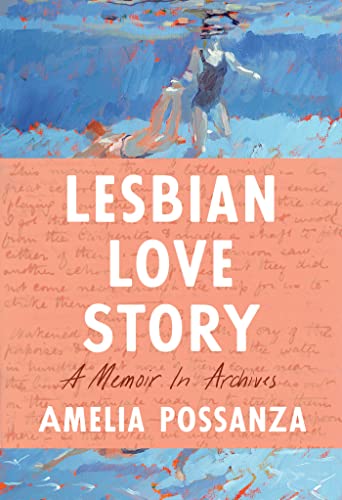 It reminded me of something David Halperin writes in How to Be Gay, basically about the process of becoming who you already are. Your book seems to delineate a lot of the lesbian counterpoints to Halperin. For example, Louisa May Alcott isn't a chapter header, but you return to her a lot. What sparked your interest in her?
It reminded me of something David Halperin writes in How to Be Gay, basically about the process of becoming who you already are. Your book seems to delineate a lot of the lesbian counterpoints to Halperin. For example, Louisa May Alcott isn't a chapter header, but you return to her a lot. What sparked your interest in her?
Like what you were saying about defining gayness, I feel like so many young girls define themselves through Alcott's work. Talking to a queer friend whose cat died unexpectedly, she said the cat was the runt of the litter, "She was a real Beth." It's like a metric to measure who you are by.
So much of why I read, and why I read when I was little, was because I wondered what life was going to be like. What does a lesbian life look like? Had I read a novel with a lesbian protagonist at that age? No, but I had Little Women. And that set up, for women of the era up until now, what life was going to be like: you got married; you rebelled and had an intellect, but you still got married; or you died! Those are the options in that book.
And then I found that quote about how she's half persuaded that she's a man--there's the gender thing--but then it's conflated in her era with sexuality. She said she'd never been in love with a man, but there are so many pretty girls who have her heart. I realized she didn't have the words to talk about what was going on with herself. Himself? There's something that's lost there, and some people have made a very strong argument that Louisa May Alcott may have been a trans man, who went by Lou, and wanted to write. I'm not here to make that decision for anyone; I'm of the opinion that there are some people we'll just never know about.
A big part of my project is asking: What did the word "lesbian" mean over time? At the moment she was alive, that word might have been fitting for her, just because that was all that was understood. But I want to be very clear that this isn't the history of lesbians as they are now, but instead asking what this word has meant. Louisa May Alcott was a person who was in the orbit of that word--which came from Lesbos--but we have no way to know. Our conception and our understanding of gender and sexuality can't be mapped onto people who lived in different eras.
You write about taking your time in deciding on that word for yourself, eventually identifying with "lesbian" in college. How has that word evolved for you over the course of your research?
To me, it's almost become a ridiculous word. In college, I thought it was great, but then growing up I feel more complicated. I don't want to associate myself with the lesbian separatists of the '70s. I don't want to have essentialist ideas about who's a woman and who isn't. Some people have switched to "Sapphic" as a way to expand that definition. But I also love that "lesbian" freaks people out. There's no other word like it. Everyone just looks horrified when they hear it. It can generate a laugh even if there's no joke. There's a line in that movie Bend It Like Beckham where the mom of one of the girls says, "Get your lesbian feet out of my shoes!" And the whole joke is that she has said the word "lesbian." So, I've come back around to think of it as a great, silly word that can freak people out but also mean a lot of things. The OG lesbian, Sappho, had a husband! This idea of purity feels like a really recent one.
There's a tension there, right? Between wanting to be visible and recognized as this outsider identity from the mainstream, even though that identity is a dangerous one. Why is that visibility so important when it also makes us targets?
This goes back to your question about why these seven pairings. When I started this project, I was really angry because I know about all these gay men in history, so I thought I'd write an essay about how gay men take up so much space. But I quickly realized that I wanted to find these lesbians that I haven't been hearing about, instead of getting hung up on my resentment.
Early on, people asked if I was going to write about Emily Dickinson and Eleanor Roosevelt, these very famous people who have a lot of speculation around them. But I was much more interested in exactly what you're talking about: Who are the people who aren't remembered for the usual historical reasons? Who are the people who risked it because they wanted to live a different kind of life than what was prescribed for them? The farther you go back, the more that risk was taken, not just because of an intense sexual attraction or internal gender identity--that was definitely part of it!--but the other part was the roles that women were offered were so limiting. I think a huge part of the risk was wanting to reject the prescribed life for women of the era, and replace it with a life centered around different values.
Like, what was Mabel Hampton famous for? I think she's incredible because she helped to found the Lesbian Herstory Archives, taking care of the stories of so many of her contemporaries in the Harlem Renaissance. Mary Casal, before she met Juno, was an inventor. She didn't want to be a wife and a schoolteacher. Joan Nestle (of the Lesbian Herstory Archives) said it best, when we talked about the idea of fame, that taking that risk "is fame enough." That risk being touching other women, which is the language that Joan uses for it, but for me it's the risk to define life on your own terms.
Your book really illustrates how lesbians have cared--for their stories, for each other, for gay men during the AIDS crisis. And I was struck by the way you show your own form of care by inlaying text from your primary sources, creating something like a palimpsest. How did you decide on that format?
A big part of it was that the first person I found was Mary Casal. I read her memoir and realized that she was saying that she was in love with women. We don't have that from Emily Dickinson or Eleanor Roosevelt in the same way. Yet I never knew that this person was out here at the turn of the century, saying, "Here I am, in a relationship with a woman." It's wild.
I also didn't want to be labeling people as queer who did not self-identify that way. Using their own words was important to me, to show that I'm not guessing that these people are queer. I'm not making up the way they talk about their passion or their feelings or their gender roles. Being a stud or a wifey--I never would have known that "wifey" was the word people used in the '40s and '50s to talk about their femme partners.
In a nerdy way, too, I'm so concerned with the archives. I don't want to be the only one looking at this stuff. My dream is for other people to find their own role models. If we had more of these stories as our inspiration, what would our world look like? --Dave Wheeler, associate editor, Shelf Awareness
Book Candy
Book Candy
Newly discovered " 'mad and offensive' texts shed light on the role played by minstrels in medieval society," the Guardian reported.
---
Criticaster, for example. Merriam-Webster looked up "11 words for people who are bad at what they do."
---
Microsoft co-founder Bill Gates offered some reading recommendations in his "great books, songs, and shows for the summer."
---
"Before e-readers, a 1930s writer reinvented the book with 'Readies,' " Mental Floss noted.
Great Reads
Sacha Lamb's 'Immigrant Fairytale'
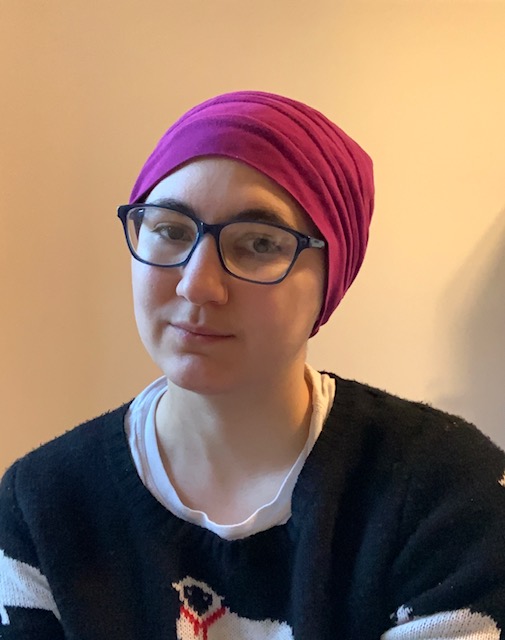 Earlier this year, Sacha Lamb won both the Stonewall Award and the Sydney Taylor YA Book Award for outstanding books that authentically portray the Jewish experience, and also received a Printz Honor for their debut, When the Angels Left the Old Country (Levine Querido).
Earlier this year, Sacha Lamb won both the Stonewall Award and the Sydney Taylor YA Book Award for outstanding books that authentically portray the Jewish experience, and also received a Printz Honor for their debut, When the Angels Left the Old Country (Levine Querido).
It can be quite intimidating to win an award like these for a debut, but I imagine it could also feel invigorating and affirming--how do you feel?
I certainly feel like I've given myself a tough act to follow, but on the other hand, it's very validating to have this kind of recognition for a book that I wrote straight from my heart. I really wrote this story for fun and put everything I love the most into it, and clearly that's come through for the readers, so I guess I just have to keep hold of that sincere feeling!
Would you give our readers your two-sentence pitch for When the Angels Left the Old Country?
It's an Ellis Island-era immigrant fairytale starring an angel and a demon who are Talmud study partners and leave their shtetl to rescue a girl who's gotten into trouble on her way to America. On the way, they discover that the "Golden Country" is a complicated place full of magic and mystery and murders.
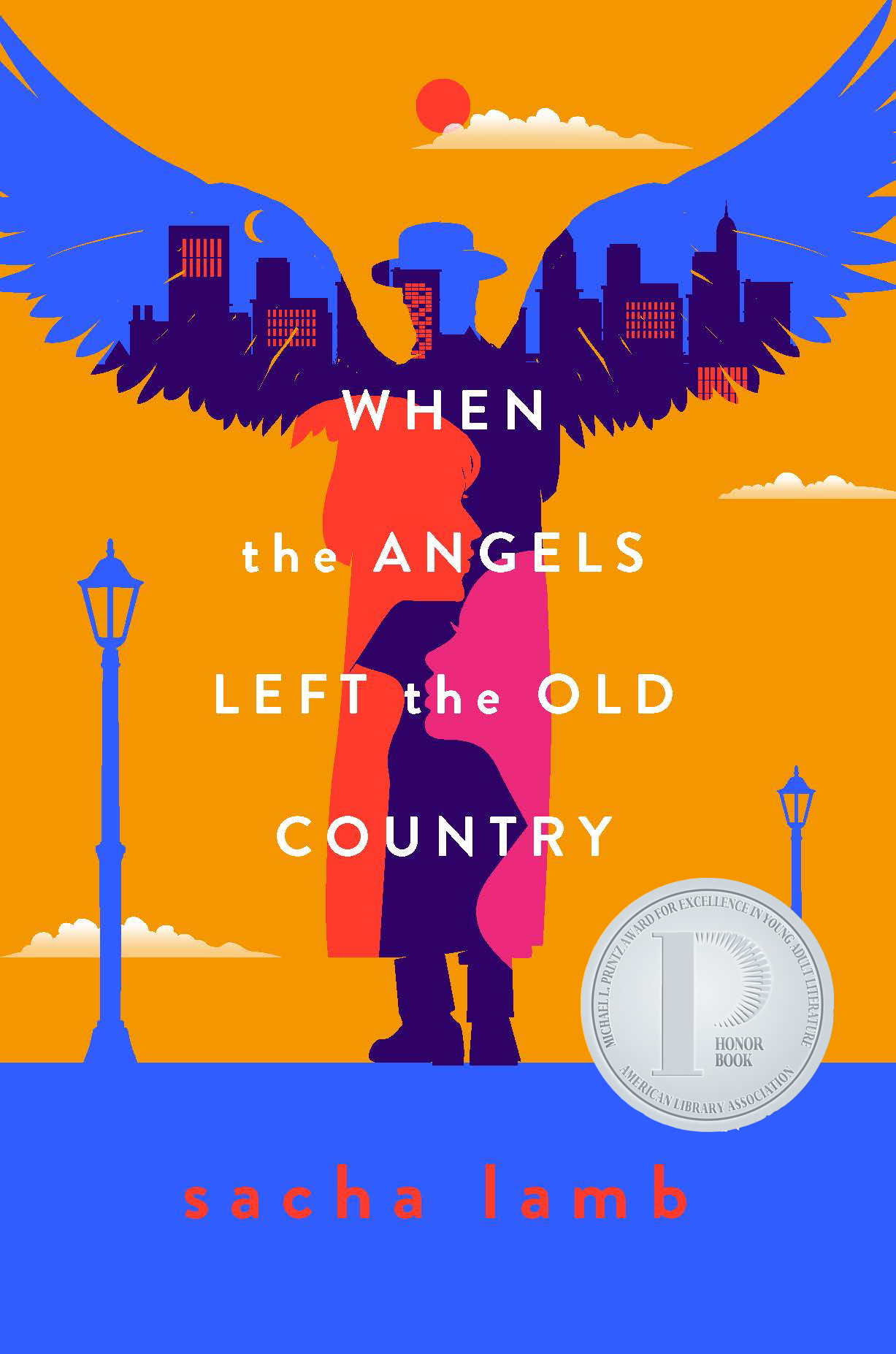 This novel has been compared with Good Omens and Elatsoe, two fabulous and very funny books--how do those comparisons feel to you?
This novel has been compared with Good Omens and Elatsoe, two fabulous and very funny books--how do those comparisons feel to you?
I love both of these books! When I first got the offer from Levine Querido, I was telling everyone, "I'm going to be on a list with Darcie Little Badger!" I love how she handles folklore with both Native and European supernatural elements. Good Omens obviously has the angel/demon odd couple thing going on, but it's set in a Christian mythological universe, so in that way it's very different. Both comps give an angle on Angels that hopefully intrigues people enough to check it out and find out what makes it unique!
What was your inspiration for this book? For how long did Uriel and Little Ash live in your brain before you began to tell their story?
The first draft was actually incredibly quick from inspiration to completion. I think it took me two months. I had the idea of an angel/demon queer chavrusa pairing, I started writing thinking it was going to be a short story, and next thing I knew it was a draft of a novel. The path has been very smooth for this book, in a way that is very, very unusual, it's been kind of a whirlwind. I credit the incredible narrative energy that's contained in the bickering angel and demon partnership!
Did you have to do any research while writing this book?
I kind of got the research "for free" because I had just finished my master's thesis in history when I started writing it. That was focused on Jewish immigration in the 1920s, so I read up on the whole period from 1880-1930. The folklore aspects I had been researching for a few years starting from a different YA project. I did have to brush up on some of the specifics of the Ellis Island encounter for the book, but in a way, I got to cheat by having done all the research before I started writing.
What was the editorial process like?
It was a lot of fun; I was working with really great editors. Obviously, everyone knows Arthur Levine, but Maddie McZeal, who was the assistant editor on this, was also so great. They really helped push me in the directions that the story needed to go to be the strongest version of itself. There's always some struggle involved in taking things apart and putting them back together, but it's worth it.
After the awards announcements, you tweeted, it's "very touching to see this extremely Jewish book recognized for its queerness, and extremely queer book for its Jewishness." I love this sentiment. Could you speak more to it?
The queer and Jewish elements of the book are intertwined quite closely, and that was a deliberate effort that I made, to make sure that Judaism and queerness weren't in opposition to each other within the story. The goal with that is to help readers who have felt conflict between those sides of their identities--queer people who've felt rejected by elements of Judaism, Jewish people who've faced antisemitism in the queer community--to find a place where their whole self belongs. This isn't the only queer Jewish YA by any means; the last couple of years have been very exciting in that regard with books like The City Beautiful and From Dust, a Flame even bringing in the fantasy element. But it's a message that bears repeating. You don't have to give up any part of yourself if you don't want to. There is a place for you, and it is even possible to imagine that others like you existed in the past. That's one of the things I hope people take away from this story.


